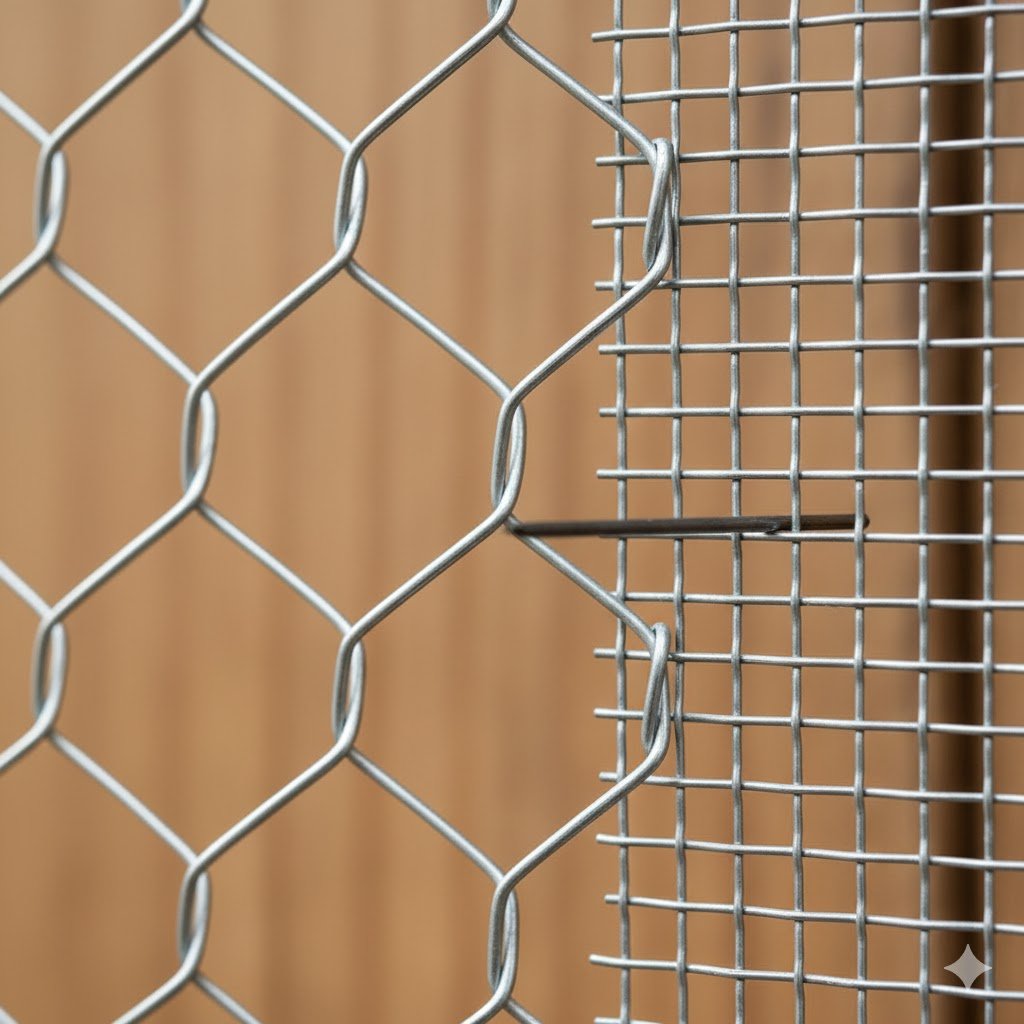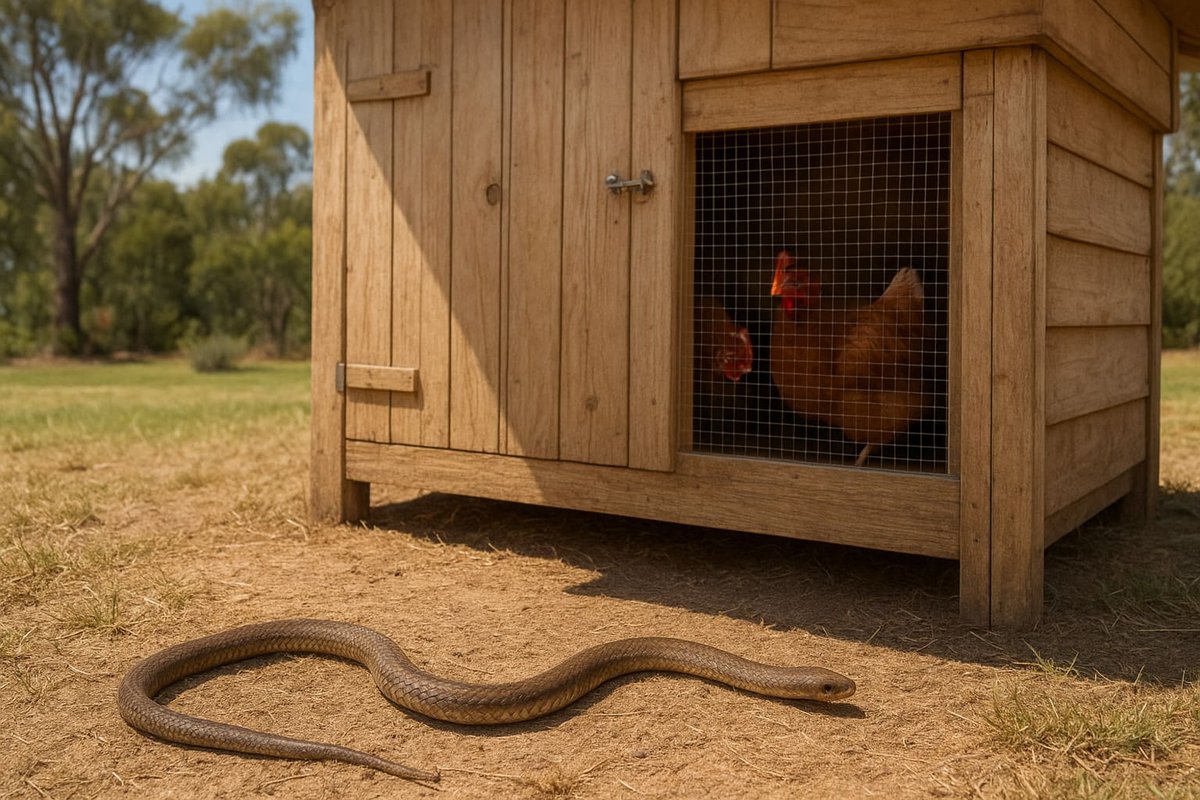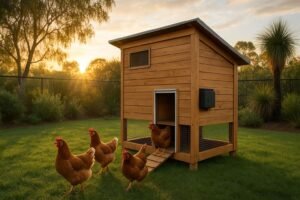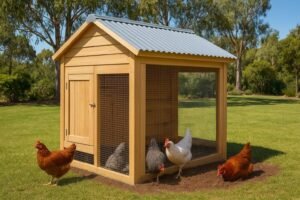Keeping your chickens safe in Australia means dealing with some of the world’s craftiest predators. Snakes are a major and persistent threat, but they are not unbeatable. A secure coop is your number one line of defence.
This comprehensive guide will give you everything you need to know to make your coop a fortress. We’ll cover the exact materials to use, the best designs you can build or buy, and the critical mistakes to avoid. Whether you’re a DIY builder or looking for the best pre-made coop for sale in Australia, these actionable tips will help you protect your flock for good.
First, let’s understand exactly what you’re up against and why this is so important.
Why Snake-Proofing Matters for Backyard Chickens in Australia
Keeping backyard chickens in Australia is a rewarding experience, but it comes with a unique challenge: snakes. Australia is home to some of the world’s most dangerous snakes, and many of them, like the Eastern Brown, Tiger Snake, and Red-Bellied Black Snake, are commonly found in backyards.
But it’s not just the venomous snakes you need to worry about. Larger species like Carpet Pythons and Diamond Pythons are also a major threat. According to wildlife experts at the Australian Museum, a small venomous snake might be after your eggs or baby chicks, but a python is strong enough to kill and eat a full-grown adult hen.
Protecting your flock isn’t just a good idea—it’s essential for safe and happy chicken keeping. This guide will walk you through the best snake-proof chicken coop designs, materials, and tips for Australian “chook” owners, whether you’re raising Isa Browns or Australorps.
Understanding what you’re up against is the first step. Now, let’s look at what “snake-proof” actually means in practice.
What Makes a Chicken Coop Snake-Proof?

A “snake-proof” coop is one that is completely sealed against predators. This means creating a 360-degree barrier that a snake simply cannot get through, under, or over. For more easy fixes, check out these predator-proofing basics.
Myth vs. Reality: The Problem with Chicken Wire
The most common mistake new chicken owners make is using standard chicken wire. While chicken wire (with its 25mm-50mm holes) is great for keeping adult chickens in, it does almost nothing to keep predators out. As RSPCA Australia’s predator protection guidelines confirm, a snake, goanna, quoll, or fox can tear through it or squeeze right in.
The Gold Standard: ¼ Inch (6.5mm) Hardware Cloth
This is the most critical rule. Snakes can squeeze through tiny gaps. A baby Eastern Brown snake can be as thin as a pencil and can get through a 10mm gap. This means that even ½ inch (12.5mm) mesh is not fully snake-proof.
The “gold standard” for predator-proofing is ¼ inch (about 6.5mm) galvanised hardware cloth. This heavy-duty welded mesh is also called “snake mesh” or “rodent mesh.” Its holes are too small for even baby snakes to get through, and it’s strong enough to stop rodents from chewing it.
Solid Construction: A 360-Degree Sealed Box
A snake doesn’t just use the door. It will exploit any weakness. A truly snake-proof coop has no gaps. This means:
- Solid floors (plywood, concrete, or solid timber) in the coop itself.
- No gaps in the corners, roofline, or floor.
- All vents and windows must be securely covered with ¼ inch hardware cloth.
With these core principles in mind, let’s look at some popular coop designs and how they stack up.
Top Snake-Proof Chicken Coop Designs for Australia
While you can buy pre-made coops, the “best” design is often one that combines smart features—whether you build it yourself or buy it.
Design 1: The Raised ‘Fortress’ Coop (Best for DIY)
This design is raised off the ground on solid legs (at least 30cm). This makes it harder for snakes and rodents to find an entry point and gives you clear visibility underneath.
- Pros: Easy to see predators; harder for them to access. The coop itself has a solid floor, making it simple to seal.
- Cons: You still need to secure the nesting box, vents, and door with ¼ inch mesh. The run area on the ground is separate and must also be secured. Explore more predator-proof chicken coop designs for inspiration.
Design 2: The Fully Secured Walk-in Run (Good for Space)
This popular design features a standard coop attached to a tall, walk-in run that is completely enclosed.
- Pros: Allows your chickens to forage safely over a larger area.
- Cons: This is a major “Buyer Beware” category. Many popular brands like Omlet sell walk-in runs, but they are not snake-proof by default. Their mesh is often 25x75mm or larger, which is big enough for snakes to get in, as frustrated customers have reported. A walk-in run is only snake-proof if you personally line the entire thing (including the top) with ¼ inch hardware cloth. Read our walk-in chicken run review for more details on popular models.
Design 3: The ‘Hybrid’ Solution (Pre-Fab + DIY)
This is the most realistic option for many people. You buy a sturdy timber coop from a brand like Somerzby or Backyard Chicken Coops, and then you spend an afternoon reinforcing it.
- Pros: Saves you the time of building a full structure from scratch.
- Cons: You must assume it is not snake-proof out of the box. This means lining the entire coop and run—including laying mesh on the ground (an apron) and under the coop—with ¼ inch hardware cloth.
As you can see, the ‘best design’ almost always involves some DIY work to make it truly secure. If you’re building from scratch or modifying a pre-fab, here’s the process to follow.
How Do You Build a Snake-Proof Chicken Coop?
Building your own snake-proof coop is often the most reliable and cost-effective option. Here is a step-by-step guide to the most important parts.
Step 1: Secure the Floor (The Most Common Failure Point)
Snakes and rodents love to get in from below. You have two main options:
- For the Coop (House): Use a solid floor made of thick plywood, metal, or even concrete. This is easy to clean and seal.
- For the Run: You must create a “mesh apron.” This means laying ¼ inch hardware cloth flat on the ground. Dig a trench and bury the mesh 30-45cm deep, and also extend it 30cm outwards from the coop walls. This 90-degree bend stops anything from digging under.
Step 2: Install ¼ Inch (6.5mm) Hardware Cloth Everywhere
Cover every single opening. This includes all windows, vents, and any gaps. Do not use flimsy staples, as a strong predator (or even a determined snake) can push them out. Secure the mesh using a combination of screws and large-head washers for a permanent, tight fit. Balance security with airflow—check our chicken coop ventilation guide for details.
Step 3: Seal Every Crack and Gap
A snake can fit through any gap its head can. Walk around your coop with a tube of silicone sealant and weather stripping.
- Seal all corners where walls meet.
- Seal the gap between the walls and the roof.
- Seal around the nesting box attachment.
- Use weather stripping around the main door and the nesting box lid to create a tight seal when closed.
Step 4: Don’t Forget the Door
A 1cm gap under your coop door is a welcome mat for a snake. Your door must be solid and close flush against a solid frame. Add a secure, predator-proof latch that can’t be rattled open. An automatic chicken coop door is an excellent upgrade, as it ensures the coop is sealed every night.
Building a secure coop is a big job, but it’s crucial. You might be wondering if you can cut corners on mesh size. Let’s cover that right now.
Can Snakes Get Through Half Inch Hardware Cloth?
Yes, baby snakes absolutely can.
This is a critical point. Many people assume ½ inch (12.5mm) mesh is fine because it stops rats. While it will stop adult snakes, it is not small enough to stop young, baby snakes. In spring, baby Eastern Browns and other species are hatchlings. They are incredibly small and can easily wiggle through ½ inch mesh. Even poultry suppliers’ technical guides on predator-proofing recommend a mesh of 11mm or smaller to be safe. Using ½ inch (12.5mm) mesh gives you a false sense of security, which is the most dangerous thing.
If ½ inch mesh is risky, then standard chicken wire is completely useless.
Can Snakes Fit Through Chicken Wire?
Yes, easily. Almost all snakes can.
Standard chicken wire often has holes that are 1 inch (25mm) or even 2 inches (50mm) wide. This is wide enough for almost any snake, as well as rodents, quolls, and goannas. Chicken wire is a ladder, not a barrier. It is only designed to keep chickens in, not to keep predators out. If your coop uses chicken wire for protection, it is not predator-proof.
This is why you must be so careful when buying a pre-made coop, as many are advertised incorrectly or use “chicken wire” in their runs.
Snake-Proof Chicken Coop for Sale in Australia (Buyer’s Guide)
If you’re not a DIY person, you can look for a snake-proof chicken coop for sale. When shopping, you must be a smart customer and ask the right questions.
What to Ask Before You Buy
- “What is the exact mesh size in millimetres on the coop and the run?”
- If they say “12.5mm” or “½ inch,” it is not baby-snake-proof.
- If they say “chicken wire” or “25mm,” it offers no snake protection.
- You are looking for ¼ inch (6.5mm) mesh as the standard.
Popular Australian Chicken Coop Brands (The Hard Truth)
- Royal Rooster: These are sturdy Australian-made coops. However, their standard mesh is 25x25mm, which is not snake-proof. Their optional “mini-mesh” upgrade is 12.5mm (½ inch), which, as we’ve covered, is still not small enough to stop baby snakes.
- Omlet (Eglu & Walk-in Runs): These are very popular and look great. However, their runs are not snake-proof. The mesh on their walk-in runs is large (e.g., 25x75mm and 50x75mm). Customer reviews confirm that pythons can and do get into these runs. To make an Omlet run snake-proof, you must line the entire thing yourself with ¼ inch hardware cloth. If considering an Omlet model, see our guide to assembling an Omlet Eglu Cube.
- Somerzby / Backyard Chicken Coops: These brands offer a huge range of timber coops. They are a good starting point, but you must assume they need modification. Check the mesh size on the specific model. The safest bet is to buy one for its solid frame and plan to add your own ¼ inch mesh and floor apron.
If you’re on a budget, building yourself or modifying a second-hand coop is often the best option. Here are some places to find inspiration.
Free Snake-Proof Chicken Coop Designs & Plans
You can find many snake-proof chicken coop plans online. DIY forums, community websites like ‘Backyard Poultry’, and Australian-specific Facebook groups are excellent resources. You can start with these free chicken coop plans and adapt them for snake-proofing. These are great places to find local, tested plans that work for others in your area.
Remember to always check your local council regulations before you start building. Most councils have rules about how large your coop can be and how far it must be from your property line.
Once your coop is built and secure, the job isn’t over. Let’s answer some common questions about day-to-day management.
Maintenance & Safety Tips (The ‘Snake-Proof’ Lifestyle)
A snake-proof coop is not a “set-it-and-forget-it” project. It requires regular maintenance to keep it secure.
Make Your Yard Hostile to Snakes
This is your first line of defence. Keep your grass mown short, especially around the coop. You must remove all potential hiding places:
- Get rid of woodpiles, or store firewood far from the coop.
- Remove sheets of corrugated tin or debris.
- Clear away piles of rocks, bricks, or garden waste.
- Maintain good flock health practices, like setting up a dust bath for natural mite prevention, as a clean area is easier to monitor.
Control the Rodent ‘Buffet’
This is the most important prevention tip. If you have no rodents, you have very little reason for a snake to visit. Following backyard poultry management best practices is key. Learn more about how to keep rats out of your chicken coop to reduce snake attractions.
- Use a rodent-proof feeder. A “treadle feeder” (which only opens when a chicken steps on it) is the best investment you can make.
- Store all feed in sealed metal bins. Rats can chew through plastic.
- Clean up all spilled feed before dusk.
Manage Water Sources
Snakes get thirsty. Fix all leaky taps and hoses near the coop. Consider switching from open water bowls to “nipple drinkers,” as this stops snakes (and rodents) from getting an easy drink.
Your Weekly Inspection
Once a week, walk the perimeter of your coop and run. Check for any new holes, rusted sections of mesh, gaps where the ground has settled, or any place a predator might be testing for weakness.
The ‘What If’ Plan
If you do find a snake in your coop or yard, do not try to catch or kill it. As government authorities like the NSW DPI advise, most snake bites in Australia happen when people try to interfere with the snake. It is also illegal to kill native snakes.
- Keep your family and pets inside.
- Keep an eye on the snake from a safe distance.
- Call a local, licensed snake catcher for safe and professional removal. Have their number saved on your phone.
This might seem like a lot, but integrating these habits is the best way to ensure the long-term safety of your flock.
FAQ: Snake-Proofing Your Chicken Coop
What else attracts snakes besides eggs or chickens?
Snakes are primarily attracted to rodents. Rats and mice are drawn to spilled chicken feed, and snakes follow the rodents. Snakes are also attracted to reliable water sources (like open chicken drinkers or leaky taps) and hiding places (like woodpiles, tall grass, or junk near the coop).
How often should I collect eggs?
Collect eggs every single day, without fail. A nest box full of eggs is an open invitation for a snake. In summer, try to collect them twice a day if possible.
What is the best snake-proof mesh?
The best and most reliable is ¼ inch (6.5mm) galvanised hardware cloth. It’s strong, won’t rust quickly, and is small enough to stop even baby snakes.
Do snake repellents (like mothballs or sulfur) work?
No. Experts and snake catchers agree that commercial snake repellents, electronic devices, and chemical products (like mothballs or sulfur) are completely ineffective and a waste of money. Mothballs are also toxic and should be kept away from pets and chickens.
What about planting snake-repelling plants?
Plants like marigolds, lemongrass, and wormwood have strong smells that snakes may dislike. However, they are not a barrier. Do not rely on them for safety. A snake will happily slither through a marigold patch to get to a rat.
I heard Guinea Fowl can help?
Yes, Guinea Fowl are excellent “alarm” animals. They are not snake fighters, but they will make an extremely loud, high-pitched noise if they spot a snake, alerting you and your chickens to the danger.
Conclusion: Keep Your Chickens Safe from Snakes
Protecting your “chooks” from snakes is a must-do for any backyard chicken keeper in Australia. It takes more than just buying a coop; it requires a smart, proactive approach.
Remember the three key rules for true chicken coop safety:
- Use ¼ inch (6.5mm) hardware cloth on every single opening.
- Seal all gaps to create a 360-degree barrier.
- Control all rodents by managing feed and water.
By choosing a smart design, modifying it correctly, and maintaining a clean, secure environment, you can ensure your backyard chickens stay safe and healthy for years to come.

Oladepo Babatunde is the founder of ChickenStarter.com. He is a backyard chicken keeper and educator who specializes in helping beginners raise healthy flocks, particularly in warm climates. His expertise comes from years of hands-on experience building coops, treating common chicken ailments, and solving flock management issues. His own happy hens are a testament to his methods, laying 25-30 eggs weekly.


